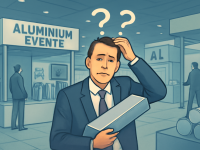For years, the conversation around carbon dioxide has been oversimplified. Governments and environmental organisations have labelled CO2 as the primary driver of climate change, implementing policies aiming at drastic reductions in emissions. While the urgency to address climate change is real, the broad-brush approach to carbon reduction often ignores nuance. This is more so for industries that are already part of the solution. The secondary aluminium industry is instrumental in lowering emissions, yet it is often subjected to the same restrictive policies as high-emission sectors.
This raises a fundamental question: Is CO2 truly an enemy, or is the real issue how we manage it?
The Misunderstood Role of CO2
Carbon dioxide is not inherently harmful. It is a fundamental part of life on Earth, essential for photosynthesis and the global carbon cycle. Throughout history, CO2 levels have naturally fluctuated, often much higher than today, without leading to mass extinction. The real issue is not its presence but the rapid increase caused by industrialisation disrupting climate stability.
Despite this, the approach to CO2 reduction often fails to account for industry-specific realities. The aluminium industry, particularly the secondary aluminium sector, is a prime example. Recycling aluminium requires only 5% of the energy needed for primary production, making it a natural choice for reducing emissions. Yet, rather than receiving recognition for efficiency, the industry is often subjected to carbon reduction mandates. As a result, this fails to differentiate between high-emission and low-emission aluminium production.
Regulations that Hurt Recycling Instead of Helping
The biggest flaw in current carbon policies is assuming all emissions are equally harmful and every industry must achieve net-zero at the same pace. It is problematic for aluminium recycling, where some CO2 emissions are unavoidable as the energy required to melt metal at temperatures above 600°C. The push for full electrification of industrial processes is often promoted as the ultimate solution, but the reality is more complex. If the electricity used for aluminium melting comes from coal or gas-fired plants, is the net environmental impact truly an improvement? Shifting emissions from one place to another does not solve the problem.
Another issue is overregulation, which can discourage recycling rather than promote it. If secondary producers face excessive carbon taxes or unrealistic emission limits, they may struggle to remain competitive. In the worst case, this could lead to manufacturers relying more on primary aluminium, which has a significantly larger carbon footprint. Instead of treating recyclers under the same strict guidelines as high-carbon industries, policies should focus on making scrap utilisation more efficient.
A critical strategy to enhance the sustainability of secondary aluminium cast houses is integrating advanced sorting systems, de-coating equipment, and closed-loop recycling practices. Sorting systems enable cast houses to use cleaner scrap, reducing contamination and improving melting efficiency. De-coating equipment removes organic residues from scrap before melting, lowering the formation of harmful emissions and improving metal yield. Closed-loop systems allow maximum material recovery and minimising waste. The system ensures that recycled aluminium can be reintroduced into the production cycle with minimal environmental impact.
Recycling as the Future of Low-Carbon Aluminum
The secondary aluminium industry should not be considered an afterthought in the global decarbonisation effort. If governments and environmental agencies are serious about reducing carbon footprints, they must recognise aluminium recycling as a climate-positive industry. More than 75% of all aluminium ever produced is still in use today, thanks to its recyclability. Expanding the role of recycled aluminium in manufacturing should be a priority, not an industry forced to fight against policies that fail to acknowledge its advantages.
The goal should not be eliminating CO2 at all costs but to optimise its impact. Minimising waste, improving energy efficiency and making carbon work for us rather than against us. Implementing sorting, de-coating and closed-loop systems will help secondary aluminium cast houses incorporate cleaner scrap into their processes. Furthermore, this shall reduce CO2 emissions and strengthen the industry’s role in sustainable manufacturing.
The real challenge is not CO2 itself, but how we approach emissions. If we rethink the way we manage industrial carbon, the aluminium recycling industry won’t just survive. It will lead the way in building a more sustainable and efficient future, creating real green aluminium.
As a conclusion, to create a truly sustainable aluminium industry, we must shift the narrative around CO2 and focus on practical, high-impact solutions. The secondary aluminium sector already plays a vital role in reducing emissions. By employing the right strategies, such as improved sorting, de-coating and closed-loop recycling, it can enhance its environmental benefits. Policymakers, industry leaders and environmental advocates must work together to support these initiatives rather than imposing blanket regulations failing to consider industry realities. By prioritising innovation and efficiency, we can ensure that recycled aluminium continues to be the foundation of a greener, more responsible manufacturing future.





